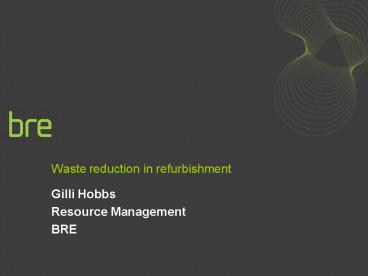Waste reduction in refurbishment - PowerPoint PPT Presentation
1 / 21
Title:
Waste reduction in refurbishment
Description:
420 million tonnes of resources used per year ... 26% of waste can be packaging. Void space of 40% in ... Co-ordinate site safety with waste minimisation ... – PowerPoint PPT presentation
Number of Views:55
Avg rating:3.0/5.0
Title: Waste reduction in refurbishment
1
Waste reduction in refurbishment
- Gilli Hobbs
- Resource Management
- BRE
2
Key facts and figures
- 420 million tonnes of resources used per year
- 90 million tonnes of CDE waste produced per
year - 10 wastage rates
- 26 of waste can be packaging
- Void space of 40 in skips
- 200 million on landfill tax
3
Wasted resources in the UK
Source Defra 2002/03
420 million tonnes of construction products per
year
4
Key Drivers
- Legislation
- Landfill Directive
- Hazardous Waste
- Duty of Care
- Fly-tipping
- Policy
- Code for Sustainable Homes
- Site Waste Management Plans
Fiscal measures Landfill Tax Aggregates Levy
5
Client requirements
- Increasingly requiring improved environmental
performance and evidence - Specifying use of waste monitoring and targets
- Use of EcoHomes and BREEAM
- Central Government Procurement Policies
- Code for Sustainable Homes
6
True cost of Waste
- 8 cu yd skip
- Skip hire 85
- Labour to fill skip 163
- Cost of materials put in skip 1095
- TOTAL COST 1343
- (Source AMEC)
7
Benchmarking
8
SMARTWaste System
Reduce waste
SMARTStart
SMARTStart
SMARTAudit
BREMAP
SalvoMIE
Reuse and recycle
9
EPIs and KPIs
- Environmental Performance Indicator
- m3 of waste per 100m2 floor area
- Key Performance Indicator
- - m3 of waste per 100,000
- Based on limited SMARTStart figures in 2004
- Average KPI 84.4 (residential)
- Average EPI 11.7 (residential)
10
National construction waste benchmarking programme
- Defra RD Autumn 2005 industry advisory group
- Set minimum reporting guidelines
- Create focal point for collecting data website
- Target of 1000 sites over 2.5 years
- Construction, refurbishment and demolition
- Residential, commercial, leisure, education etc..
- Set EPIs for comparison e.g. m3 waste/100m2
- Predict for site, company, local, region and
national - Resource management planning, building regs,
contractual targets etc..
11
Common construction key waste products
- Plastic packaging
- Cardboard
- Timber pallets
- Insulation
- Plasterboard
- Timber general
- Timber packaging
- Blocks
- Bricks
- Miscellaneous
12
Common causes of waste
- Off cuts
- Recyclable packaging
- Temporary materials
- Clearing site
- Reusable packaging
- Excavation material
- Excess deliveries
- Unsuitable storage
13
Lessons learnt from GMV and other sites
- Establish a company/ site benchmark
- Appoint waste champion
- Talk to suppliers returnable packaging
- Monitor and publicise waste reduction performance
- Contractually oblige sub contractors to
participate - Identify key waste products and implement
reduction plans - Co-ordinate site safety with waste minimisation
- Download GMV Best practice guides from
www.smartwaste.co.uk
14
Reduce flytipping
- Estimated cost of flytipping 100 million per
year (EA) - Reported flytipping increasing due to
- Increased disposal costs, Increased awareness/
reporting - Rise in organised environmental crime
- From April 2004 flycapture EA and LA web
based reporting system - CD waste 20 flytipped material (higher in
SE) - Legitimate contractors at cost disadvantage
- Proposed tagging to reduce flytipping esp.
Hazardous waste
15
Reduce hazardous waste
- 5 million tonnes produced in England and Wales
- 1.3 million tonnes from CD waste and asbestos
- July 2004 end of co-disposal hazardous and non-
hazardous landfill est. 12 sites available - Increase in waste classed as hazardous estimated
7.5 MT treated timber, contaminated land - Register sites producing hazardous waste
- Reduce use of hazardous construction materials
and products - Talk to your suppliers
16
Reuse and design for deconstruction
- Reclamation sector 3.3 MT
- Fixings and material type
- Use demolition products in new construction
17
Demolition/refurbishment audits
- Quantify key demolition products
- Optimise the potential income
- Find and develop local markets
- Identify employment opportunities
- Identify reuse on site
- Inform during the contract
- Minimise journeys
- Quantify environmental impacts
18
Closing the loop Example - post consumer flat
glass
Pristine quality of post consumer flat glass from
waste windows.
Contaminants are main barriers to end markets.
Main contaminants are masonry and ceramics
Post consumer flat glass waste back into
fibreglass Insulation. Next step, back into float
glass production maybe?
19
T ZERO feasibility study
20
T ZERO follow on project
WP1- decision making tool based on matrix and
tailored to user WP2 resource efficiency in
planned refurbishment projects (if not, why
not) WP3 monitoring to improve data and
decision making WP4 innovation needs Public
housing and void property focus
21
Conclusion
- Reduce Reducing waste will save money and is
usually the best environmental option - Recycle Waste materials can become high quality
resources minimise contamination and add value - Close the loop Recycled building products can
have enhanced performance characteristics, save
money and reduce environmental impacts































